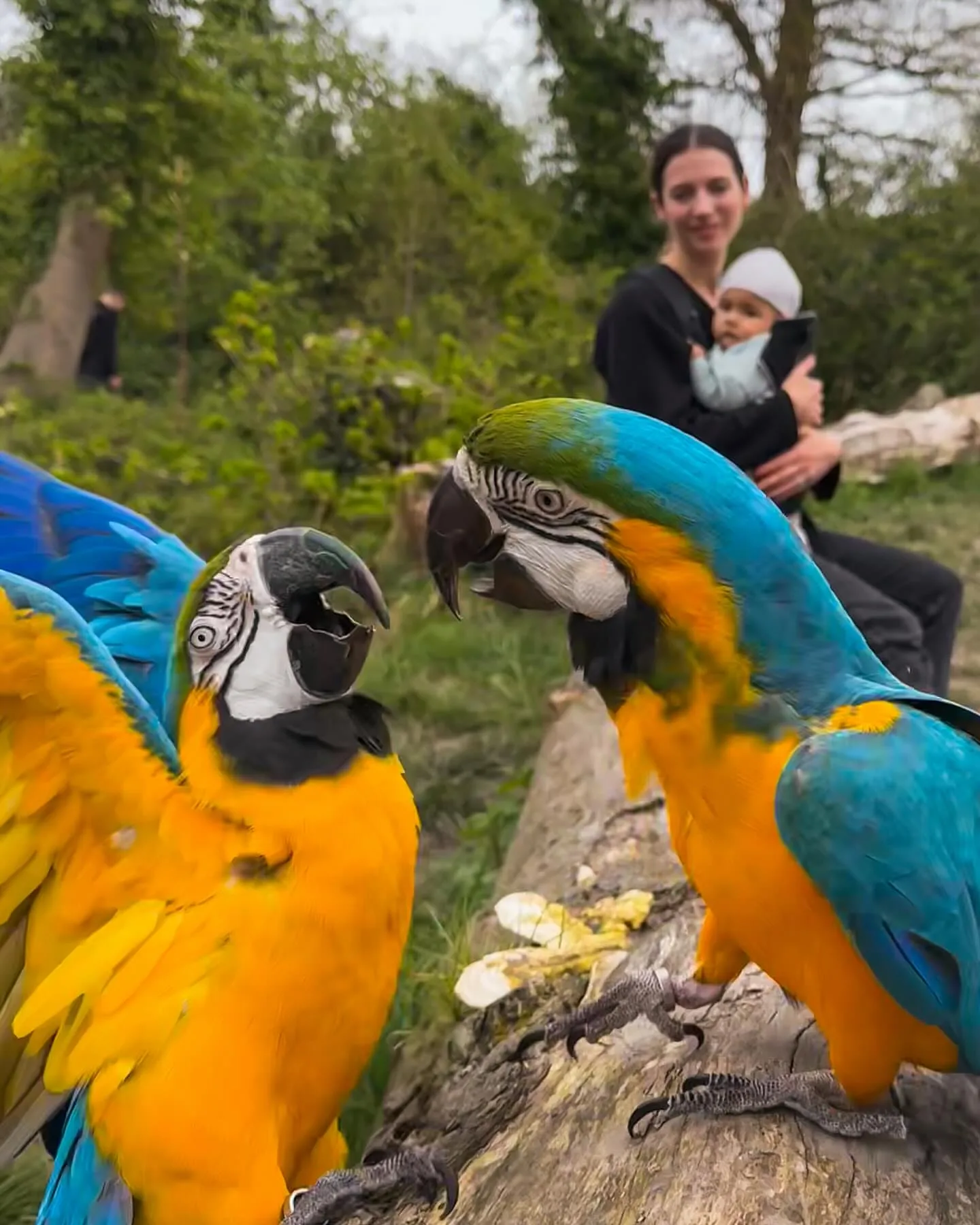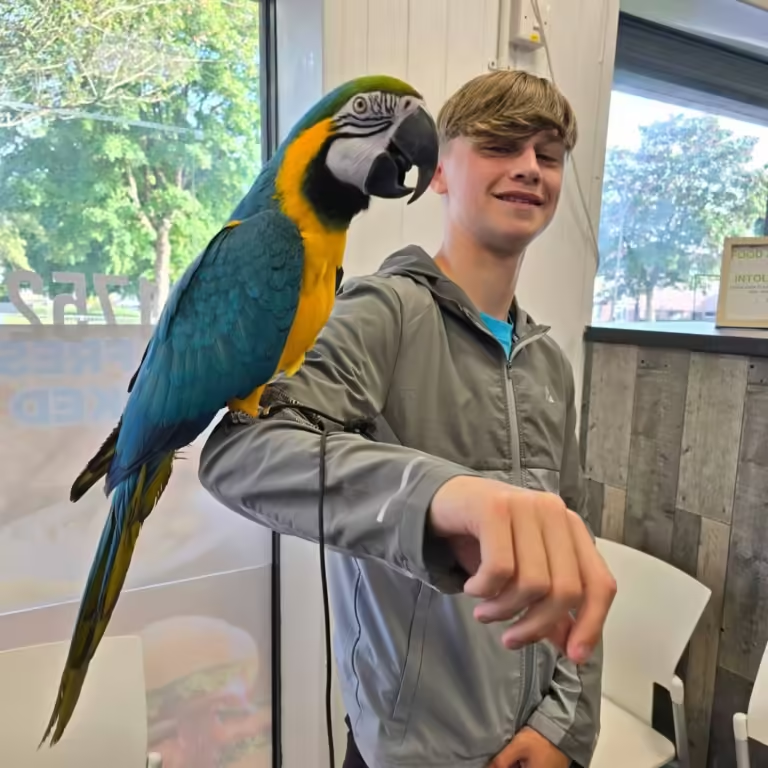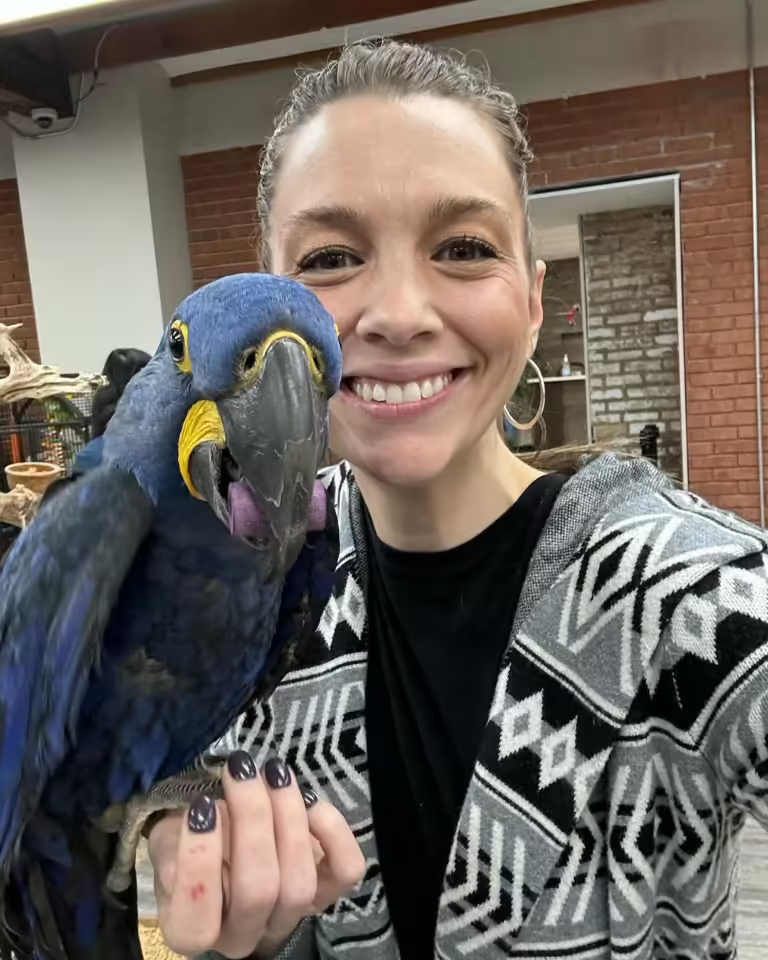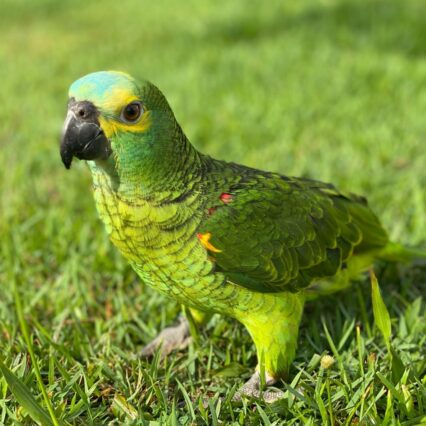- May 23, 2024
Scarlet Macaw Parrot: 10 Colorful Facts to Amaze You

Dive into the vibrant world of scarlet macaw parrots with our essential guide. From their striking plumage to their playful demeanor, these magnificent birds captivate all who encounter them. Discover fascinating facts about their intelligence, social nature, and unique behaviors that make them beloved companions for bird enthusiasts worldwide.
Explore our top picks for scarlet macaw parrot essentials and accessories in the reviews below. Scroll down to find out more about how to care for these colorful creatures and enhance your experience as a proud scarlet macaw owner.
Browse our shop for beautiful birds. Find your perfect parrot companion today
-
Sale Product on sale
 My Name is ELLIOTT, Male Talking Congo African Grey. 20% Off Today – Don’t Miss Out!
My Name is ELLIOTT, Male Talking Congo African Grey. 20% Off Today – Don’t Miss Out!$1,600.00Original price was: $1,600.00.$1,400.00Current price is: $1,400.00. -
Sale Product on sale
 My Name is FILO, Female Amazon Parrot. 20% Off Today – Don’t Miss Out!
My Name is FILO, Female Amazon Parrot. 20% Off Today – Don’t Miss Out!$1,600.00Original price was: $1,600.00.$1,400.00Current price is: $1,400.00.
Key Takeaways
- Appreciate the scarlet macaw parrot for its vibrant plumage colors and impressive wingspan.
- Understand the intelligence of scarlet macaws as mimics and their loud vocalizations.
- Consider the long lifespan and monogamous mating habits of scarlet macaws in captivity.
- Raise awareness about the endangered status of scarlet macaws and their native habitat in Central/South America.
- Recognize the scarlet macaw as a symbol of strength in Mayan culture.
- Evaluate the responsibilities and considerations of owning a scarlet macaw as a popular pet choice worldwide.
Vibrant plumage colors
The scarlet macaw flaunts a mesmerizing blend of scarlet, blue, and yellow feathers, creating a striking appearance. These colors are not just visually appealing but also serve a practical purpose in the bird’s habitat. In the dense forests where they reside, the vibrant hues act as a form of natural camouflage, helping them blend seamlessly with the colorful surroundings.
Moreover, the vivid colors of the scarlet macaw play a significant role in their social interactions. The hues aid in attracting mates and asserting dominance within their community. This unique feature sets them apart from other bird species, making scarlet macaws truly captivating creatures to observe in the wild.
Impressive wingspan
The scarlet macaw parrot showcases an extraordinary wingspan reaching up to 1 meter. This remarkable feature allows for agile flight and effortless gliding through the forest canopy. With its wide range of motion, the scarlet macaw utilizes its wings for long-distance travel and swift maneuvers, making it a master of the skies. The upper wing coverts play a crucial role in maintaining stability during flight, ensuring precision and control in various environments. The hooked beak complements the impressive wings, enabling the bird to navigate through dense vegetation with ease.
The scarlet macaw’s ability to soar gracefully over river edges, trees, and open woodlands highlights the significance of its wingspan in adapting to diverse habitats. This adaptation is further enhanced by the bird’s keen sense of direction, allowing it to thrive in different landscapes effortlessly.
Loud vocalizations
The scarlet macaw parrot communicates through loud, high-pitched squawks and screams, using these vocalizations to establish territory and alert others of danger. These calls are distinctive and can be heard from a considerable distance. The parrot’s vocal efforts are not just for communication but also play a crucial role in its survival in the wild. By utilizing its powerful voice, the scarlet macaw effectively navigates its surroundings, ensuring its safety and well-being. These vocalizations serve as a means of social interaction within the species, fostering bonds and maintaining group cohesion. The upper sides of forests where scarlet macaws reside resonate with their vibrant calls, creating a symphony of sound unique to these majestic birds.
Intelligent mimics
Scarlet macaw parrots are intelligent mimics known for their exceptional ability to mimic human speech and sounds. Their cognitive intelligence is evident in how they learn and imitate various sounds, showcasing a remarkable capacity for vocalization. This mimicry behavior goes beyond mere repetition; it serves as a crucial aspect of their social interactions and bonding within their flock.
Research has shown that scarlet macaws exhibit complex behaviors when mimicking, indicating a deeper level of understanding and communication skills. Their capability to replicate sounds with precision highlights their cognitive prowess and adaptability. This unique trait sets them apart as fascinating creatures with a remarkable talent for vocal imitation.
In the wild, these parrots engage in mimicry not only for communication but also as a means of establishing connections with other members of their group. This behavior underscores the importance of vocalization in their social dynamics and overall well-being.
Long lifespan in captivity
Scarlet macaws can live up to an impressive 75 to 90 years in captivity, making them one of the longest-living parrot species. Due to this extended lifespan, they require specialized care and attention from their owners. Building a strong bond with its human caretakers is crucial for ensuring the well-being and longevity of these vibrant birds.
- Lifespan: 75 to 90 years in captivity.
- Care requirements: Specialized care and attention needed.
- Bonding: Establishing a strong bond with human caretakers is vital.
Providing a nurturing environment, a balanced diet, regular veterinary check-ups, and mental stimulation are essential aspects of maintaining the health and happiness of scarlet macaws living in captivity. Their long lifespan offers rewarding companionship for those willing to commit to their care over the years.
Monogamous mating pairs
Scarlet macaw parrots form lifelong monogamous bonds with a single partner, showcasing remarkable loyalty in their relationships. This unique behavior extends to their breeding habits, where they engage in cooperative breeding and parenting efforts. The strong bond between mates plays a crucial role in enhancing breeding success and ensuring the survival of their offspring. These birds exhibit a deep sense of commitment to their partners, working together harmoniously in raising their young. By fostering such strong pair bonds, scarlet macaws exemplify the importance of cooperation and mutual support within their family units.
Endangered species status
The scarlet macaw faces significant threats from habitat destruction, illegal pet trade, and hunting. These factors have led to a decline in wild populations and local extinctions in certain areas. Conservation efforts play a vital role in safeguarding the future of this vibrant species. Collaborative initiatives involving governments, conservation organizations, and local communities are working together to protect the scarlet macaw’s habitat and combat illegal trafficking. This bird species belongs to the subfamily of Psittacinae and is listed on CITES Appendix I, highlighting its critical conservation status. Preserving their nesting sites and ensuring sustainable practices are essential steps towards securing the survival of these majestic birds.
Native to Central/South America
The scarlet macaw parrot is native to the humid evergreen forests of Central and South America. It thrives in a variety of ecosystems, from tropical rainforests to savannas. This stunning bird plays a crucial role in maintaining ecological balance by aiding in seed dispersal and pollination. With its vibrant plumage and impressive size, the scarlet macaw is a sight to behold in the wild. Known for its diet that includes nuts, insects, and seeds, these parrots are essential for the health of their natural range. The scarlet macaw, belonging to the genus Ara, is not only a symbol of beauty but also a key player in the biodiversity of its habitat.
Symbol of strength in Mayan culture
Revered as a symbol of strength, courage, and resilience in Mayan mythology, the scarlet macaw parrot holds profound significance. In ancient Mayan art and artifacts, this bird is portrayed as a powerful and majestic creature, embodying the essence of vitality and vigor. The scarlet macaw’s vibrant plumage and distinctive features make it a striking representation of vitality and life force in Mayan traditions.
The scarlet macaw parrot not only symbolizes physical strength but also embodies spiritual significance and a deep connection to the natural world in Mayan culture. Its presence signifies harmony with nature, resilience in the face of challenges, and the ability to overcome obstacles with grace. This revered bird serves as a powerful emblem of endurance and fortitude in the rich tapestry of Mayan beliefs.
Popular pet choice worldwide
Scarlet macaws are a popular bird species in the pet trade, known for their vibrant plumage and sociable personalities. Their common name reflects their stunning scarlet red feathers, making them a sought-after pet globally. With a significant presence in homes around the world, these birds require specific care to thrive. Scarlet macaws are intelligent creatures that need mental stimulation and ample space to spread their wings. Responsible ownership is crucial, including providing a proper diet, regular vet check-ups, and social interaction. Due to concerns about the impact of the pet trade on wild populations, it’s essential for owners to ensure they source their birds ethically and legally. Ensuring legal compliance and prioritizing the well-being of these magnificent birds is paramount for those considering welcoming a scarlet macaw into their home.
Final Remarks
You’ve now glimpsed the vibrant plumage colors, impressive wingspan, loud vocalizations, and intelligent mimics of the scarlet macaw parrot. Their long lifespan in captivity, monogamous mating pairs, endangered species status, and historical significance as a symbol of strength in Mayan culture make them a unique species native to Central and South America. Their popularity as a pet choice worldwide highlights their appeal and charm.
Consider supporting conservation efforts to protect these magnificent creatures and their habitats. By spreading awareness about the scarlet macaw’s endangered status and advocating for sustainable practices, you can contribute to preserving this iconic species for future generations. Take action today to make a difference in safeguarding the scarlet macaw parrot’s existence.
Frequently Asked Questions
What are the vibrant plumage colors of scarlet macaw parrots?
The scarlet macaw parrots showcase vibrant red, blue, and yellow feathers that create a stunning visual display, making them one of the most colorful and eye-catching bird species in the world.
How long do scarlet macaw parrots live in captivity?
Scarlet macaw parrots have a long lifespan in captivity, often living up to 50 years or more when provided with proper care, nutrition, and enrichment activities to support their well-being.
Why are scarlet macaw parrots considered intelligent mimics?
Scarlet macaw parrots are known for their intelligence and ability to mimic human speech and sounds in their environment. Their impressive cognitive abilities make them popular among bird enthusiasts seeking interactive pets.
What is the endangered species status of scarlet macaw parrots?
Scarlet macaw parrots are classified as an endangered species due to habitat loss, illegal pet trade, and poaching. Conservation efforts are crucial to protect these majestic birds from further decline in the wild.
Where are scarlet macaw parrots native to?
Scarlet macaw parrots are native to Central and South America, where they inhabit tropical rainforests and woodlands. Their natural range includes countries like Mexico, Peru, Brazil, and Bolivia, where they play a vital role in the ecosystem.
Tags
What do you think?
Related Articles

Find Parrots for Sale in Aurora IL: Top 5 Must-Visit Spots
Finding the perfect parrot in Aurora, IL, is an exciting adventure for bird lovers. This city offers various options for

Find Parrots for Sale in Trenton NJ: Top 5 Must-See Spots!
Finding the perfect parrot can be a fun adventure. Trenton, NJ, offers plenty of options for bird lovers. From local

Find Parrots for Sale in Woodbridge Township NJ: Top 5 Must-See Spots!
Finding the perfect parrot can be a fun adventure. Woodbridge Township, NJ offers plenty of options for bird lovers. From


